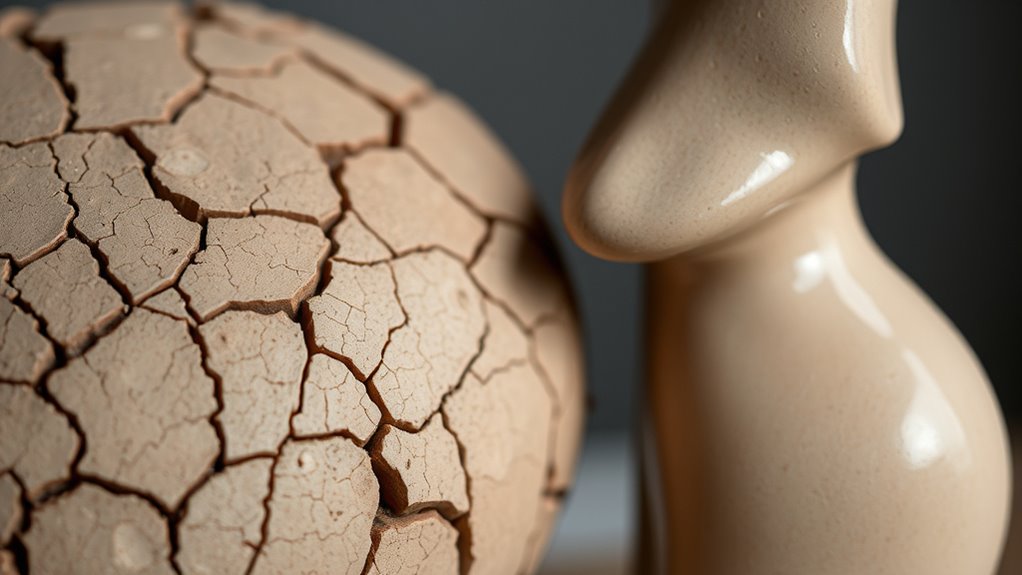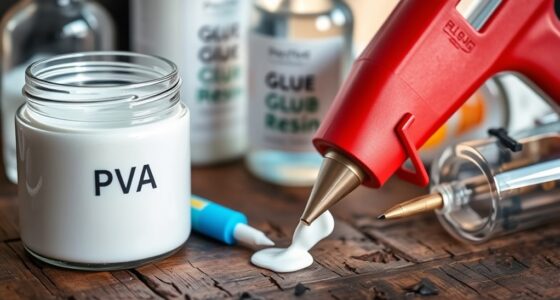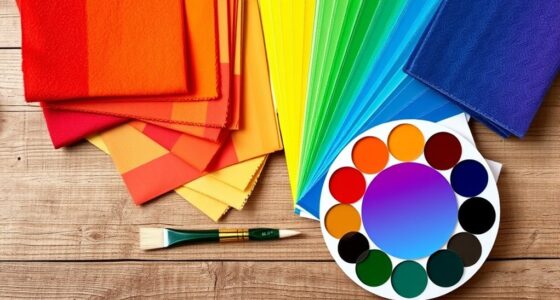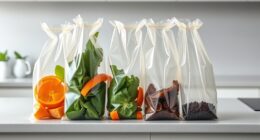Choosing between air-dry and oven-bake clay depends on your project needs. Air-dry clay is lightweight, easy to mold, and great for quick, soft models but can fade or crack over time without sealing. Oven-bake clay is more durable, better for detailed work, and retains color well after baking. If you want long-lasting, vibrant finishes, oven-bake might be better; for quick, simple designs, air-dry works well. Keep exploring to discover which is best for your craft.
Key Takeaways
- Air-dry clay is lightweight and easy to mold but less durable and more prone to cracking or discoloration over time.
- Oven-bake clay offers a firm, durable finish with vibrant color retention, ideal for detailed and long-lasting projects.
- Air-dry clay often requires sealing or finishing to improve surface quality and protect against environmental damage.
- Oven-bake clay holds fine details well and can be carved or layered after baking without losing shape.
- Use air-dry clay for quick, lightweight projects; choose oven-bake clay for durable, detailed artwork that lasts.
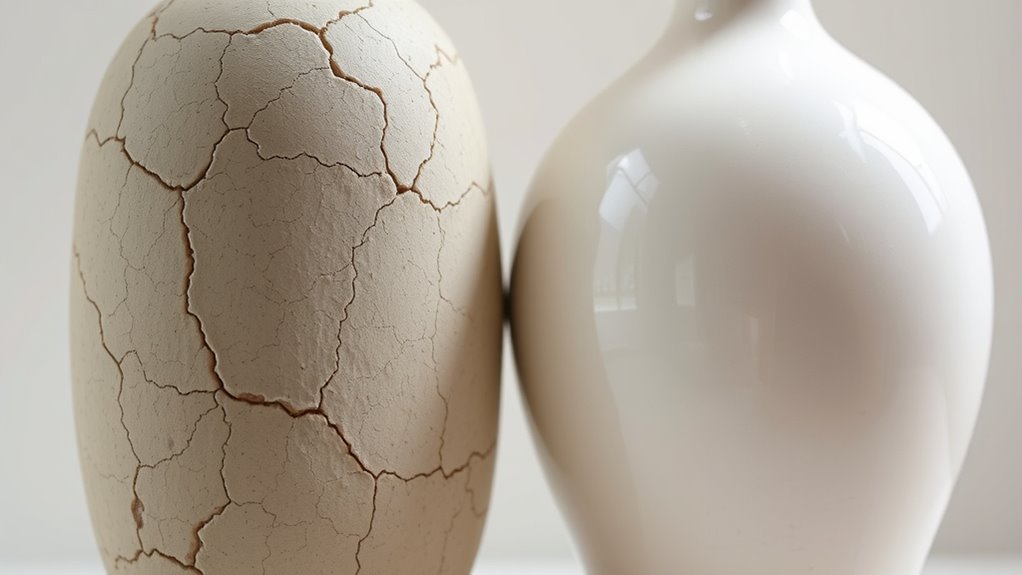
When choosing between air-dry and oven-bake clay, understanding their key differences can help you make the best decision for your project. One of the most noticeable distinctions is their texture differences. Air-dry clay tends to have a softer, more porous feel when it’s fresh, making it easy to mold and smooth out. However, it can become slightly chalky or rough once dried, especially if you don’t seal it properly. Oven-bake clay, on the other hand, generally has a firmer, more cohesive texture right out of the package. When baked, it becomes hard and durable, offering a smooth, polished surface that’s less porous. This difference in texture impacts how detailed or intricate your work can be, as oven-bake clay often holds fine details better due to its firmness after baking.
Choosing between air-dry and oven-bake clay depends on your desired texture and detail retention.
Color retention is another important factor to evaluate. Air-dry clay is more susceptible to color changes over time. Its porous nature means that pigments and paints may fade or stain more easily if not sealed properly. Also, some air-dry clays are more prone to discoloration when exposed to sunlight or moisture, which can affect the vibrancy of your finished piece. Oven-bake clay generally retains its color more effectively. Because it’s baked at high temperatures, the pigments are fused into the material, resulting in a more stable, fade-resistant color. This makes oven-bake clay ideal for projects that require long-lasting or vibrant finishes, especially if you plan to handle or display your work frequently.
Another consideration related to texture differences and color retention is the finishing process. With air-dry clay, you often need to sand, seal, or varnish your piece to enhance its appearance and protect it from damage. These steps can sometimes alter the texture, making the surface smoother or glossier. In contrast, oven-bake clay comes out of the oven with a more durable surface, reducing the need for extensive finishing. This can save you time and effort, while also ensuring the color stays bright and intact over time. Additionally, the versatility of oven-bake clay allows for more advanced techniques like carving or layering without compromising the durability of the final piece.
Ultimately, your choice depends on your project’s goals. If you want a lightweight, easy-to-work-with material with a softer feel, air-dry clay might be better, but expect some compromise in long-term color stability. If you need a sturdy, long-lasting piece with vibrant colors and fine detail, oven-bake clay offers advantages in texture and color retention. Knowing these differences allows you to select the right clay, ensuring your finished project meets your expectations.
Frequently Asked Questions
Can Air-Dry Clay Be Baked in the Oven?
Yes, you can bake air-dry clay in the oven, but you should check the manufacturer’s instructions first. Be sure to use proper clay storage and safety precautions, like ventilating your area and avoiding overheating. Baking can speed up drying and hardening, but always verify if your specific air-dry clay is oven-safe. Follow safety guidelines to prevent damage or fumes, ensuring a safe and successful project.
Which Clay Type Is More Environmentally Friendly?
Your choice of clay can be a game-changer for the planet! Generally, air-dry clay is more eco-friendly because it requires no oven, reducing energy consumption and emissions. It often uses natural, biodegradable, and sustainable materials, making it a greener option for your craft projects. By choosing air-dry clay, you support sustainability considerations and lessen your environmental impact, turning your creativity into a powerful act of eco-consciousness.
How Long Does Air-Dry Clay Take to Fully Cure?
Air-dry clay typically takes about 24 to 72 hours to fully cure, depending on the thickness of your piece and humidity levels. During the drying time, it undergoes a curing process where moisture evaporates, leaving a solid, durable sculpture. To guarantee proper curing, keep your project in a well-ventilated area, avoid touching it prematurely, and wait until it feels completely dry before painting or sealing.
Can Oven-Bake Clay Be Painted After Baking?
Yes, you can paint oven-bake clay after baking. To guarantee the paint adheres well, use proper surface preparation by cleaning and lightly sanding the baked surface. Choose suitable painting techniques like acrylics or specialized clay paint, and apply thin, even coats for the best finish. Allow each layer to dry thoroughly before adding details or sealing. This approach helps you achieve a professional, lasting look on your baked clay projects.
Is Air-Dry Clay Suitable for Outdoor Decorations?
Yes, air-dry clay can be used for outdoor decorations, but its outdoor durability depends on weather resistance. You should seal your project with a waterproof varnish or outdoor sealant to protect it from moisture, sunlight, and temperature changes. Without proper sealing, air-dry clay may crack or deteriorate quickly. So, if you want lasting outdoor decor, make certain you enhance its weather resistance with appropriate protective coatings.
Conclusion
So, whether you prefer the convenience of air-dry clay or the durability of oven-bake, both have their charm. Ironically, what seems like a simple choice can turn into a frustrating experiment, leaving your masterpiece half-dried or cracked. In the end, it’s all about your patience and passion—because no matter the method, the true art lies in your persistence. After all, sometimes the messiest attempts make the most meaningful creations.
